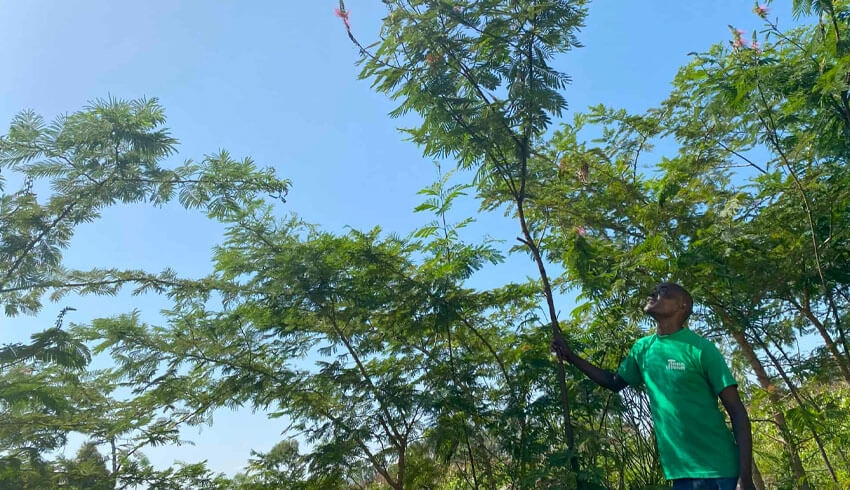in Eminence organic skin care, we are filled with gratitude for everything that nature gives us. From fruits and seeds to herbs and flowers, so many plants play an important role in our health, diet, and, of course, skin care. We’ve seen the power of organic first hand as we incorporate powerful botanical ingredients into all of our products. With that in mind, it feels right to give back to the earth that has given us so much. That’s why Eminence Organics created his 2013 Forests for the Future™.
Through this initiative, we plant a tree for every product sold. We also support farmer training and environmental restoration projects in rural areas where trees are planted. This is all made possible thanks to our generous partners. tree for the futurean amazing non-profit organization that improves the lives of poor farmers by training them. agroforestry We achieve sustainable land use while helping organize practical work to make our dreams a reality.
let’s meet david abachKenyan farmers spoke about the many benefits their farms have seen since joining the program and learned more about the real-life impact of Eminence Organic and Trees for the Future.
david’s story
When David participated in Trees for the Future hosted by Eminence. Forest garden training program In 2020, he confirmed that approximately half the hectares of his farm could be converted into farms. forest garden.
For the past decade, Trees for the Future has championed a forest garden approach. This method uses regenerative farming principles to simulate a natural forest ecosystem within existing farmland. A forest garden consists of a variety of trees, shrubs, fruits, and vegetables strategically placed to provide each plant with the support it needs to sustain itself while replenishing the land with necessary vitamins and minerals. , consists of herbs.
Through the education provided by the program, David quickly began learning about sustainable and regenerative agroforestry techniques that directly benefit his land.
better farm
Farms that incorporate forest gardens produce a wide variety of healthy and wholesome crops, giving farmers access to nutritious food. This increases biodiversity and farmers’ incomes while restoring land and capturing carbon from the atmosphere. Speaking about biodiversity, David says:[My farm] Today is better. Previously, they only planted corn and beans. But thanks to Trees for the Future, I got Kayanas trees and vegetables for food. ”
David has implemented a number of renewable agroforestry techniques in his forest garden. One of his such techniques is called alley cropping. This method uses rows of trees and shrubs to create alleys and provide the structure needed to grow multiple crops within a limited space. As mentioned earlier, David uses Cajanus (pigeon pea) in his alley crops to increase important nutrients in the soil. This acts as a living fence around the perimeter of the forest garden, enriching the soil as well as providing fodder for animals and acting as a windbreak. “Without trees…very strong winds can knock down crops.” This has damaged David’s crops and negatively impacted his quality of life.
thousands of trees
In just three years, this area of David’s land has grown from 12 trees to more than 3,300. Although these trees are still growing and reaching maturity, they are already creating a beneficial microclimate on his farm.
These trees helped David combat a problem that had previously made crops vulnerable: Kenya’s climate. “During the dry season, [a different] internal climate [Forest] It’s a garden,” David explains. Dry conditions can wreak havoc on crops, but the presence of trees “helps keep crops from drying out too much, unlike bare ground.”
Participating in carbon markets
Through his participation in the Trees for the Future program, David also gained the ability to participate in a vibrant carbon market. Carbon markets refer to systems for buying and selling “carbon credits” that allow organizations to participate in environmental projects. This will allow businesses to offset their greenhouse gas emissions to reduce the impact of carbon dioxide on the atmosphere, while also raising much-needed funding. Kenya’s Trees for the Future Forest Garden farmers can participate in carbon markets, giving David’s trees an additional source of income through the sale of carbon credits.
better soil
David continues to grow corn and beans using traditional methods outside of Forest Garden. The difference between what grows inside a forest garden and what grows outside is stark.
“There is a huge difference in soil quality,” he says. “If you compare the areas where vegetables grow along the Cajanus River with the areas where corn grows, [without Cajanus], you can see that the corn is yellow. This is different from when I use compost, which indicates a lack of nutrients. Forest Garden seems better. ” Cajanus trees enrich David’s land with nitrogen and produce nutritious, hardy crops that he can sell and use to feed his family.
promising future
From food production to climate change mitigation, David uses the forest gardens created through these efforts to build a better life for himself and his family of 13.
“Earlier, I had to take money out of my pocket to buy vegetables. Now I can get vegetables at Forest Garden, so I can buy fish or meat with the money I used to use to buy vegetables.” , I can buy school supplies for my kids.”
Since joining the Trees for the Future Forest Garden Training Program, sponsored in part by Eminence Organic Skin Care, David has been able to access the education and resources that make all of this possible. We are pleased to have played a role in providing David with a stable source of food and income so he can build a better life.
Read more about David’s story here.


